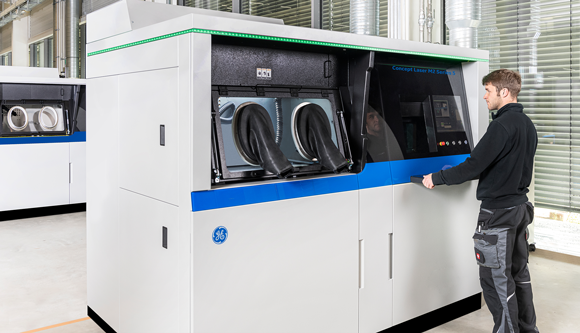GE Aviation’s Singapore facility approved to use Additive Manufacturing for engine component repair
March 31, 2022

GE Aviation reports that its Loyang, Singapore facility is the first maintenance, repair and overhaul (MRO) facility worldwide that has been approved to use metal Additive Manufacturing for commercial jet engine component repairs.
GE Aviation Engine Services Singapore (GE AESS) currently employs more than 1,700 employees in the city-state and accounts for more than 60% of GE Aviation’s global repair volume. When repairing used parts explains GE Aviation, the repair has to be customised for each individual part because each part wears differently during service.
Additive Manufacturing in repairs also offers the possibility of embracing complexity, rather than shying away from it remarks Chen Keng Nam, Executive Manufacturing Leader at GE AESS in Singapore. “This disruptive technology can be used for lots of applications, not only in aviation,” stated Chen Keng Nam. “When I see beyond the realm of repair into new-make, it’s mind-blowing to see the parts that we can design and print using additive. Now designers are making use of the ability to produce new designs that couldn’t be imagined or manufactured before with traditional methods.”
Iain Rodger, Managing Director at GE AESS, also sees the potential for metal Additive Manufacturing in MRO. “In this part of the supply chain our customers truly value faster turn-around time, and that’s what we are achieving. Using our GE Additive Concept Laser M2 machines typically halves the amount of time it takes us to repair these aircraft parts,” commented Rodger.
He went on to explain that his teams are already using Additive Manufacturing to repair parts in GE Aviation’s CF6 engines, a commercial engine on wide-body aircraft. The next goal is to include parts on the CFM56, said to be the best-selling engine in commercial aviation history.
One example is the repair of high-pressure compressor (HPC) blades that run at high speeds and tight clearances within aircraft engines. They face regular erosion and wear and tear that, over time, demand continuous repair and replacement. Repairing these blade tips used to require a long process of cutting, welding and grinding to create the proper shape.
GE Aviation has established an automated Additive Manufacturing process to repair the HPC blade tips, saving time and costs associated with labour and machining. The team created image-analysis software that maps the shape of a used blade and creates customised instructions for the Concept Laser M2 machine to build a new tip with precise alignment and profile.
“Productivity has increased with our employees able to repair twice as many parts in a day compared to the conventional repair process. Less equipment is also needed for post-processing so the floor space required is reduced by one-third. Further to that, we are currently assessing what we are going to do in turbine parts and other components beyond compressors. Day-to-day, working with customers, they will know that there’s a difference as they will be seeing their parts return to them more quickly, added Rodger.
Beyond the faster turn-around times possible with metal Additive Manufacturing in aircraft part repairs, Rodger notes that he sees another significant win for GE Aviation, for customers and for the aviation industry more broadly.
“To me, one of the significant advantages of additive is its sustainability. This is going to allow us to repair more parts and throw fewer parts into the bin, use less energy, generate less waste and have a smaller footprint. Repair capability is a big part of the sustainability journey. As the industry expands and new technology is developed, that will only increase,” he concluded.
















